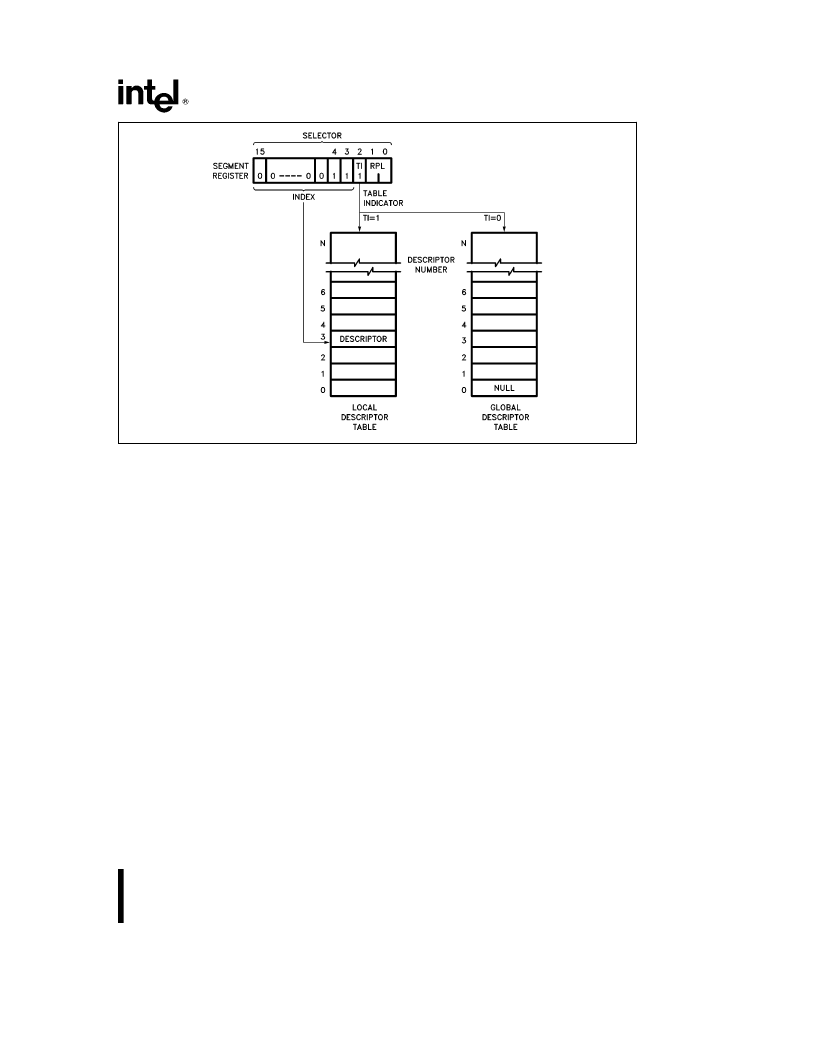- 您現(xiàn)在的位置:買賣IC網(wǎng) > PDF目錄373200 > KU386 (Intel Corp.) SX MICROPROCESSOR PDF資料下載
參數(shù)資料
| 型號: | KU386 |
| 廠商: | Intel Corp. |
| 英文描述: | SX MICROPROCESSOR |
| 中文描述: | SX微處理器 |
| 文件頁數(shù): | 29/102頁 |
| 文件大小: | 1268K |
| 代理商: | KU386 |
第1頁第2頁第3頁第4頁第5頁第6頁第7頁第8頁第9頁第10頁第11頁第12頁第13頁第14頁第15頁第16頁第17頁第18頁第19頁第20頁第21頁第22頁第23頁第24頁第25頁第26頁第27頁第28頁當前第29頁第30頁第31頁第32頁第33頁第34頁第35頁第36頁第37頁第38頁第39頁第40頁第41頁第42頁第43頁第44頁第45頁第46頁第47頁第48頁第49頁第50頁第51頁第52頁第53頁第54頁第55頁第56頁第57頁第58頁第59頁第60頁第61頁第62頁第63頁第64頁第65頁第66頁第67頁第68頁第69頁第70頁第71頁第72頁第73頁第74頁第75頁第76頁第77頁第78頁第79頁第80頁第81頁第82頁第83頁第84頁第85頁第86頁第87頁第88頁第89頁第90頁第91頁第92頁第93頁第94頁第95頁第96頁第97頁第98頁第99頁第100頁第101頁第102頁

Intel386
TM
SX MICROPROCESSOR
240187–12
Figure 4.7. Example Descriptor Selection
4.3 Protection
The Intel386 SX Microprocessor has four levels of
protection which are optimized to support a multi-
tasking operating system and to isolate and protect
user programs from each other and the operating
system. The privilege levels control the use of privi-
leged instructions, I/O instructions, and access to
segments and segment descriptors. The Intel386 SX
Microprocessor also offers an additional type of pro-
tection on a page basis when paging is enabled.
The four-level hierarchical privilege system is an ex-
tension of the user/supervisor privilege mode com-
monly used by minicomputers. The user/supervisor
mode is fully supported by the Intel386 SX Micro-
processor paging mechanism. The privilege levels
(PL) are numbered 0 through 3. Level 0 is the most
privileged level.
RULES OF PRIVILEGE
The Intel386 SX Microprocessor controls access to
both data and procedures between levels of a task,
according to the following rules.
D Data stored in a segment with privilege level
p
can be accessed only by code executing at a
privilege level at least as privileged as
p
.
D A code segment/procedure with privilege level
p
can only be called by a task executing at the
same or a lesser privilege level than
p
.
PRIVILEGE LEVELS
At any point in time, a task on the Intel386 SX Micro-
processor always executes at one of the four privi-
lege levels. The Current Privilege Level (CPL) speci-
fies what the task’s privilege level is. A task’s CPL
may only be changed by control transfers through
gate descriptors to a code segment with a different
privilege level. Thus, an application program running
at PL
e
3 may call an operating system routine at
PL
e
1 (via a gate) which would cause the task’s CPL
to be set to 1 until the operating system routine was
finished.
Selector Privilege (RPL)
The privilege level of a selector is specified by the
RPL field. The selector’s RPL is only used to estab-
lish a less trusted privilege level than the current
privilege level of the task for the use of a segment.
This level is called the task’s effective privilege level
(EPL). The EPL is defined as being the least privi-
leged (numerically larger) level of a task’s CPL and a
selector’s RPL. The RPL is most commonly used to
verify that pointers passed to an operating system
procedure do not access data that is of higher privi-
lege than the procedure that originated the pointer.
Since the originator of a selector can specify any
RPL value, the Adjust RPL (ARPL) instruction is pro-
vided to force the RPL bits to the originator’s CPL.
29
相關(guān)PDF資料 |
PDF描述 |
|---|---|
| KU80C186EC25 | 16-BIT HIGH-INTEGRATION EMBEDDED PROCESSORS |
| KU80C188EC16 | 16-BIT HIGH-INTEGRATION EMBEDDED PROCESSORS |
| KU80C188EC25 | 16-BIT HIGH-INTEGRATION EMBEDDED PROCESSORS |
| KU80L186EC16 | 16-BIT HIGH-INTEGRATION EMBEDDED PROCESSORS |
| KU80L186EC20 | 16-BIT HIGH-INTEGRATION EMBEDDED PROCESSORS |
相關(guān)代理商/技術(shù)參數(shù) |
參數(shù)描述 |
|---|---|
| KU-3C-110D | 制造商:M.E.C. Relays 功能描述: |
| KU-3C-120A | 制造商:M.E.C. Relays 功能描述: 制造商:Master Electronic Controls (MEC) 功能描述: |
| KU-3C-12A | 制造商:M.E.C. Relays 功能描述: |
| KU-3C-12D | 制造商:M.E.C. Relays 功能描述: |
| KU-3C-240A | 制造商:M.E.C. Relays 功能描述: |
發(fā)布緊急采購,3分鐘左右您將得到回復(fù)。